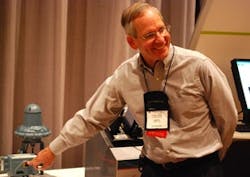Better Fieldbus "Control in Field" Saves Time and Headaches
To most process control operators and technicians, "Out here in the fields, I fight for my meals," is more than an old lyric from The Who. It's how many do their jobs, year in and year out, in a wide range of climates and in situations of varying difficulty and danger.
So saving a little precious time out there is good, and curing a few headaches is better. However, saving a lot of time and preventing many headaches is a blessing.
To that end, Invensys Operations Management today unveiled new features of its I/A Series distributed control system (DCS) that enable faster deployment of block configuration, faster device commissioning and easy set-up of control in the field (CIF) loops. It demonstrated I/A Series' new CIF capabilities on the second day of the company's 2009 Invensys North America Client Conference this week in Houston.
"This is part of our three-part strategy to excel in Foundation fieldbus (FF)," said Charlie Piper, senior development program manager, Invensys Operations Management. "We started by building a very robust foundation that made FF easy to use in 2004, added diagnostics functions in 2006, and now we've wrapped it up with CIF capabilities."
"We started with the system changes necessary to meet the basic Fieldbus Foundation standard, added tools and templates to automate and otherwise improve configurability, and then made numerous other innovations based on needs expressed by our clients, but not covered in the standard," said Piper. "For example, downloads and device commissioning, loop building and function block scheduling, and setting up devices for backup link-active scheduling are easier and faster in our implementation. This eliminates the complexity that has been a barrier for many to making the most of CIF and FF."
Users can employ I/A Series CIF to choose whether they deploy function blocks in the field devices, DCS or both. This enables greater flexibility and efficiency in many control strategies. The Fieldbus Foundation's host registration program tests the host's ability to support standard function blocks and features in Device Descriptions and Capabilities files. This ensures basic interoperability with all field devices. However, Invensys reports that it went further to make fieldbus simple to use and to give users added tools, templates and other innovations. These capabilities provide the following benefits:
- Reduced engineering time via custom and generic engineering templates, which can be nested many levels deep. Function block flexibility may be contained in the device template, device- specific applications or in a function block toolset for more generic mixing and matching.
- Faster response to operator changes by caching all standard parameters in the I/A Series' control processor. This gives instantaneous read access to DCS applications, such as HMIs or historians. Dynamic values are read into the processor every 10 seconds, with operator change commands written upon change. This minimizes the inherent delay caused by PID function blocks remote to the field devices.
- Flexible mixing of control in the field or the host. Users interact with a consistent set of standard or custom blocks, connecting output and inputs simply by dragging one to the other.
- Easy Foundation fieldbus scheduling, including ability to set the segment macrocycle, optimize timing variables and minimize dead time in the loop.
- Rapid device commissioning with a device preparation wizard that sets devices to the correct tag and address; fast, parallel database download into the blocks in the device; and a group mechanism that saves time in placing the blocks and loops on active control.
- Improved asset reliability. When implemented with Invensys' InFusion field device manager technology, I/A Series CIF becomes part of a common device configuration, commissioning and maintenance environment that provides tools to better diagnose device problems for any device from any vendor that threaten plant uptime. InFusion is the first device management solution to integrate both device type managers (DTMs) that comply with the FDT standard for advanced maintenance diagnostics and the enhanced device descriptions that also comply with the electronic device description language (EDDL) standard for device configuration.
"The main reason to use Foundation fieldbus is to do predictive maintenance in valves and other devices and be able to prevent unexpected shutdowns and improve asset reliability," said Piper. "Once you implement FF, you can look at all your loops and decide on the number you want to put in the DCS and the number you want to put in the field. The more complex loops typically go in the DCS, but the one clear advantage of control in the field is that you can schedule the execution of the blocks in PID loops back-to-back. Consequently, you get to shorten the time between when the analog block begins to execute and when you get the analog output, such as when its valves begin to move. This can minimize dead time and enable better loop performance as the loops respond more quickly to measured changes."
Piper added that the big change in I/A Series CIF is in how it engineers and deploys its software function blocks. Traditionally, function blocks could be drawn on screen as part of a loop diagram, but actual configuration still required a lot of manual configuration and programming of each device in the field. I/A Series CIF allows users to draw their diagram, but then hit a "deploy" button that sends the configuration order through the associated controllers and fieldbus interface-card modules to all the devices to configure them automatically and remotely. "The module detects that the tags on the devices specified are correct and then downloads to the software in those instruments," explained Piper. "This turns what used to be a five-day job into one that can be done in 15 minutes."
I/A Series CIF will be released in January 2010 and is scheduled to begin shipping in February 2010.


